Designed for Nikon’s Z-mount full-frame mirrorless cameras, the Nikon Nikkor Z 85mm F1.2 S is a high-speed, standard telephoto intended for portraiture, fashion and indoor sports where light levels are low.
The optical configuration consists of 15 elements in 10 groups with two aspherical elements and one ED element. ED glass helps suppress chromatic aberration, while the aspheres reduce spherical aberration, distortion, and other aberrations such as coma. Nikon’s SIC coatings and Nano Crystal Coat also feature to reduce ghosting and flare.
The Nikon Nikkor Z 85mm F1.2 S adopts two STM-type stepping actuators and uses internal focusing (IF) so there’s no extending barrel. STM stepping motors offer fast, accurate autofocus for stills and smooth and quiet focusing for video, while the adoption of two actuators enables improved optical performance at close range.
Videographers and filmmakers are also likely to be interested in the support for linear focusing on supported cameras, as well as the focus-breathing, which is said to be “minimized.” The minimum focus distance is a fairly typical 0.85 m (2.79 ft).
Externally, the S-line lens drops the mini LCD of earlier models but retains the customization options via a separate control ring and an additional L-Fn button. The lens is quite substantial with an 82 mm filter thread and weighing 1160 grams (41 oz.). It is available now for around $2,799 / €3,049.
You can view the results for all tested lenses and create your own comparisons and in-depth analyses using our interactive image lens comparison tool.
Key specifications:
- 15 elements with one ED and two aspheres in 10 groups
- Eleven-blade, rounded aperture
- Two STM-type stepper motors with close-range correction
- 82 mm filter thread
- Minimum focus distance: 0.85 m (2.79 ft)
- Weight: 1160 grams (41 oz.)
Test results
We tested the Nikon Nikkor Z 85mm F1.2 S on a 45.7 MP Nikon Z7, which has the highest-resolution sensor in Nikon’s current mirrorless lineup. The lens mounted on the Nikon Z7 achieved a DXOMARK score of 55, which is the highest score in our database for any lens regardless of focal length and indicates especially high image quality.
As you might expect of a modern design, the Nikkor Z 85mm F1.2 S has high sharpness at maximum aperture, especially in the center, and slightly higher levels when stopped down. Some diffraction effects are noticeable at small apertures.
Besides high sharpness levels, the lens’s transmission is another high point and an asset when working in low light levels. At T1.3, it’s just -0.2 EV below the stated F1.2 maximum aperture value. Vignetting is somewhat heavier than expected for a high-speed lens like this, and chromatic aberration is also slightly higher than rivals, even if it is relatively well-controlled. Both are easy to remove when correction profiles are applied in-camera or later in post-production.
Slight pincushion-type distortion is also visible, but it is well controlled and easily corrected. Overall, the Nikon Nikkor Z 85mm F1.2 S is a pricey proposition, but its optical quality can’t be denied.
As always, it’s worth looking through the detailed results and comparing them with rivals to get a clearer idea of the optical performance.
In-depth comparisons
After a long line of 85mm portrait lenses with an F1.4 maximum aperture, Nikon has introduced its first F1.2 model, designed specifically for the mirrorless Z mount. It is not the first 85 mm for that particular mount though, so we’ve compared it with the highly regarded Nikkor Z 85mm F1.8 S. At around $800, it’s some $2,000 less, so you can see what kind of premium the vaunted F1.2 aperture brings with it. We’ve also compared the new mirrorless Nikkor with one of the last great, high-speed 85mm lenses made for the Nikon F-mount by an independent maker, the Sigma 85mm F1.4 DG HSM Art. At around $1,200 the Sigma is competitively priced. All three lenses are tested on cameras with a related 45.7 MP sensor; the mirrorless Nikon Z7 and Nikon D850 DSLR.
You can see an overview of this comparison in our database.
Sharpness
Like so many modern designs particular attention has been paid to sharpness at the maximum aperture, with the Nikon Nikkor Z 85mm F1.2 S having excellent center sharpness measured at over 80% acutance. While sharpness drops in the outer field to 70% in the corners, it’s still an excellent result for a lens with an initial aperture of F1.2. The Sigma Art series, on the other hand, might only be an F1.4, but it is not far behind; indeed it’s practically as sharp in the center wide-open and has slightly better mid- and outer-field sharpness. The same can almost be said for the Nikkor’s smaller brother; it’s somewhere in between the two. At F1.8-2.0 though, the Nikkor Z 85mm F1.2 S is slightly sharper across the field, but it is practically indistinguishable from the Sigma. While that doesn’t sound like much, the F1.2 lenses of a decade or two ago wouldn’t fare as well, especially away from the center.
Stopped down to 2.8-4, the Nikkor Z 85mm F1.2 S increases in sharpness slightly in the center, but it’s at the edges where most of the improvement is made. The Sigma fares well here, too, practically matching the super-fast Nikkor. Even the diminutive Nikkor Z 85mm F1.8 S performs brilliantly with only the edges just slightly behind. Diffraction effects can be seen at F5.6 and above, which gradually lowers sharpness levels with each progressively smaller f-stop, but uniformity is superb right out to the corners.
Chromatic aberration
With lots of expensive glass in the optical design — the ED element being just one component –the Nikon Nikkor Z 85mm F1.2 S has generally well-controlled levels of chromatic aberration. Wide-open through F2.8, levels are low in the center of the frame, but it will be noticeable at the corners with subjects that have high-contrast edges. It’s low for a lens of this speed or brightness. Fringing is easier to control with slower lenses, but the Sigma has exceptionally low levels given that it’s also a high-speed lens. Even the Nikkor Z 85mm F1.8 S has very low color fringing across the image field. Nevertheless, this aberration is easy to remove in out-of-camera JPEGs and in post-processing.
Geometric distortion
The Nikkor Z 85mm F1.2 S has some pincushion distortion where the corners of the projected image extend. Some geometric distortion is more or less inevitable even at this price, and -0.3% for this focal length is still considered to be an acceptable level. The Sigma, on the other hand, breaks the trend here with no detectable distortion, and that is without correction profiles being applied. The slower F1.8 Nikkor has very low levels as well, measured at just 0.1% — exceptionally slight barreling — but this and the pincushion of the F1.2 version can be corrected in-camera and in post-processing if the relevant profiles are enabled, meaning it isn’t worth worrying about.
Vignetting (corner shading)
High-speed lenses like this, even those designed for mirrorless cameras, will exhibit vignetting, and the Nikkor Z 85mm F1.2 S has slightly heavier levels than might be expected when wide-open. However, vignetting tops just -1.6EV in the extreme corners, but the visual weighting is exacerbated by the smaller unaffected central core. On the plus side, vignetting falls away rapidly upon stopping down. At F1.8, levels are lower than the two used in this comparison, and the vignetting is negligible at F2.0 and completely free of any effects at F2.8, which is impressive without any profile correction.
Transmission
Depending on which scale you use (half or third stops), with an initial or maximum aperture of F1.2, the Nikkor Z 85mm F1.2 S can be either +0.5 or + 0.3 EV faster than an F1.4 lens. That’s the theory anyway. In practice, it’s best to measure the actual transmission at the maximum aperture. While it’s not usually issue for stills, it can be important if there’s a big difference and you’re using a handheld light meter for videography or filmmaking.
We measured the Nikkor Z 85mm F1.2 S at T1.3, which is just -0.2 EV “slower” than the F1.2 rated maximum aperture value and a real highlight of the optical design. In contrast, the Sigma 85mm F1.4 measured T1.7, which is some -0.6 EV behind the initial aperture’s stated F-number. In this instance then the F1.2 is over +0.5 EV faster than the Sigma and nearly +1.0 EV faster than the F1.8 Nikkor version, which measured an impressive T1.9.
Conclusion
The 85mm focal length remains a popular choice for portraiture and, high-grade, ultra-fast versions like this are revered by pros and amateurs alike. Such models are also in demand for indoor sports, AF speeds permitting. While we can’t comment on the autofocus performance, the optical quality of the Nikon Nikkor Z 85mm F1.2 S is outstanding. Admittedly, while there’s some lateral chromatic aberration in the outer field, it doesn’t affect much, if at all, image sharpness, and with auto correction enabled in-camera, it is unlikely you would notice it anyway. High image quality combined with high speed always comes at a price, but as a long-term investment, it’s usually money well spent.
In this review, we have compared the Nikon Nikkor Z 85mm F1.2 S mounted on a Nikon Z7 to its closest rivals from other brands. Remember that the lenses may be used on various cameras with different sensors, or in some cases on different camera systems using different mounts, so the results will vary between them.
As usual, you can create your own comparisons and in-depth analyses using our interactive image lens comparison tool.


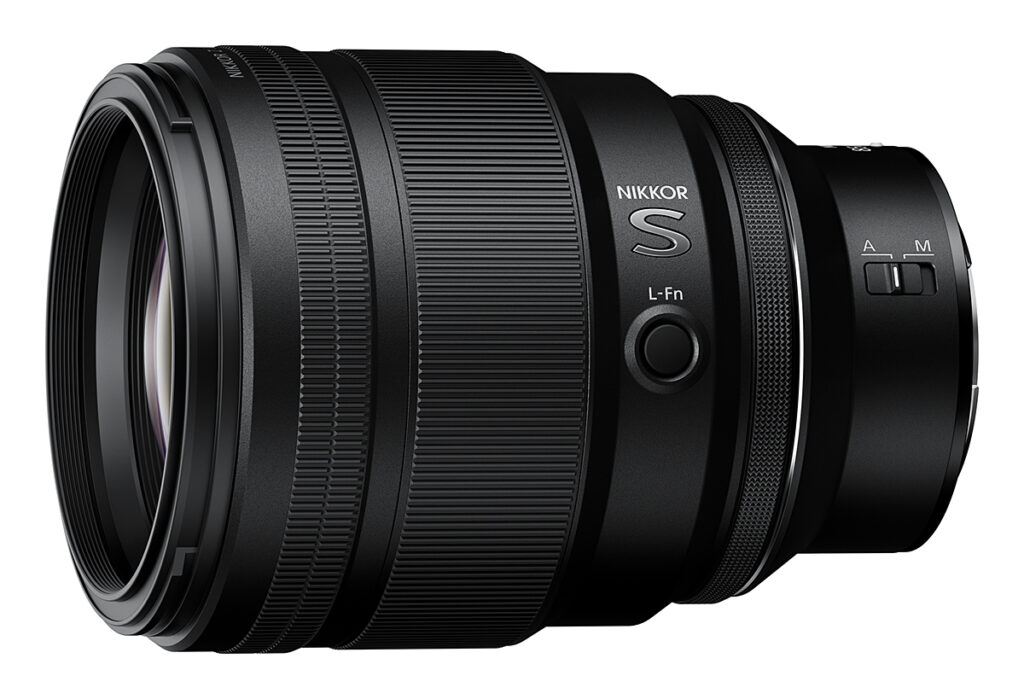


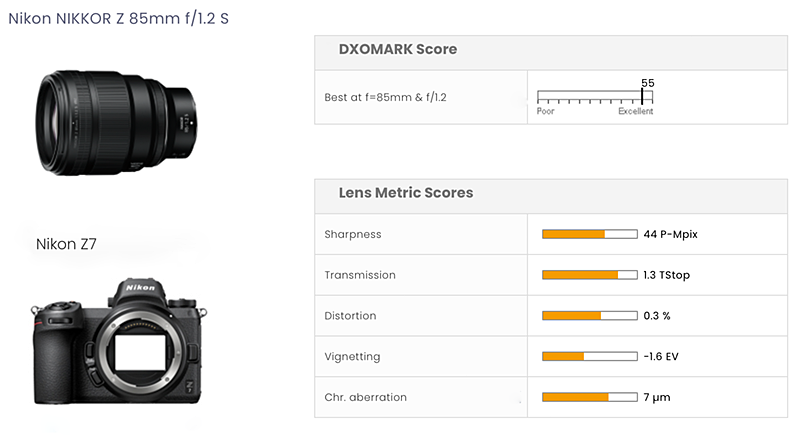
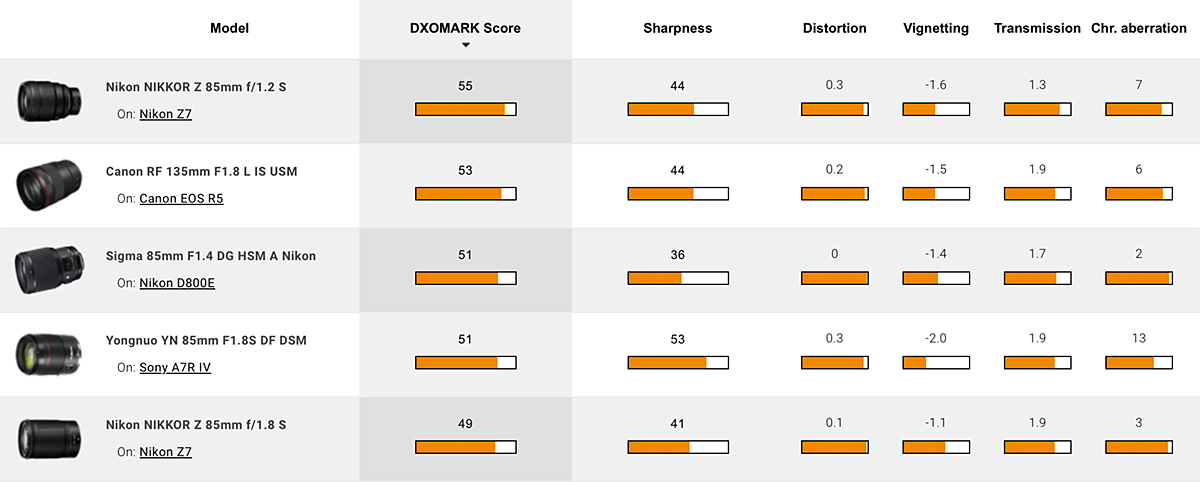
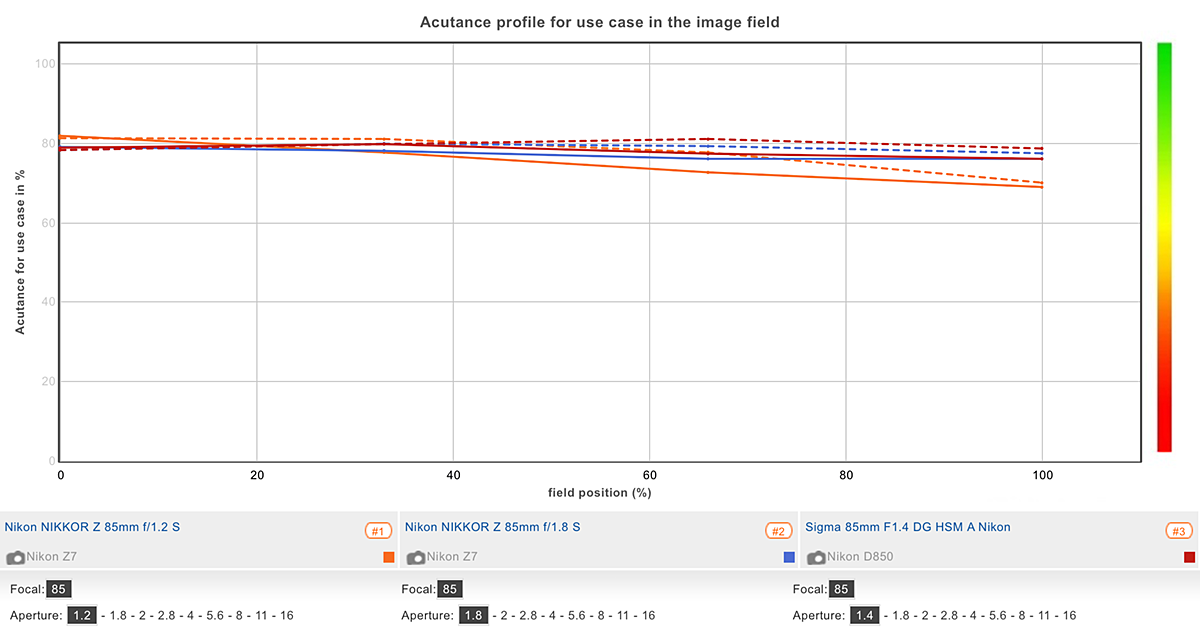
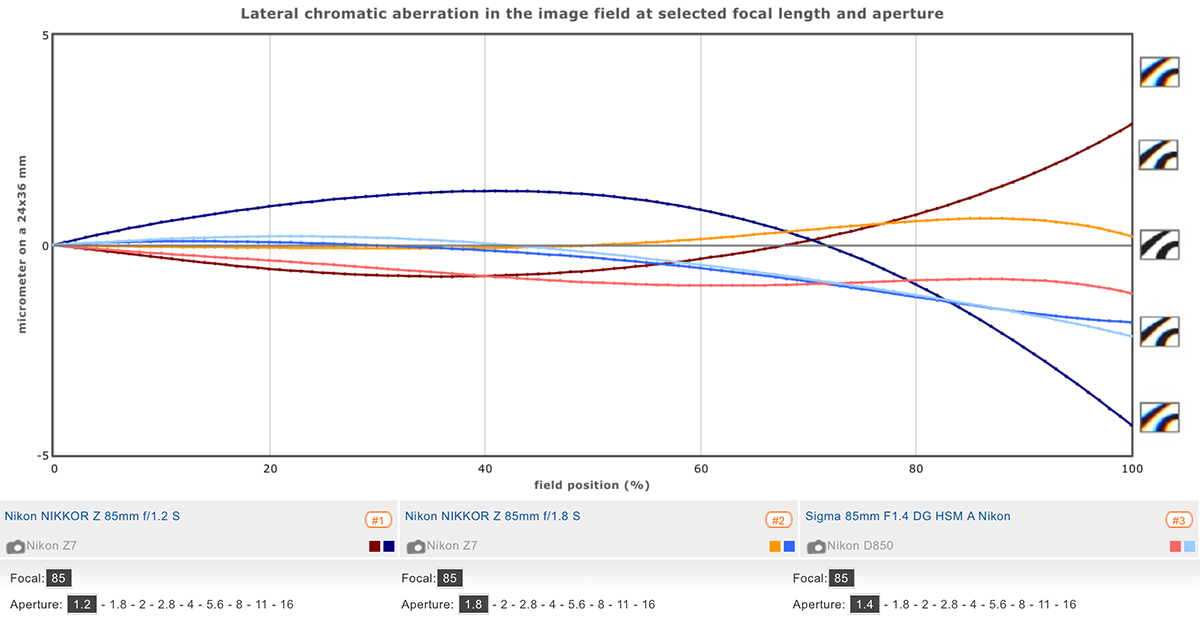
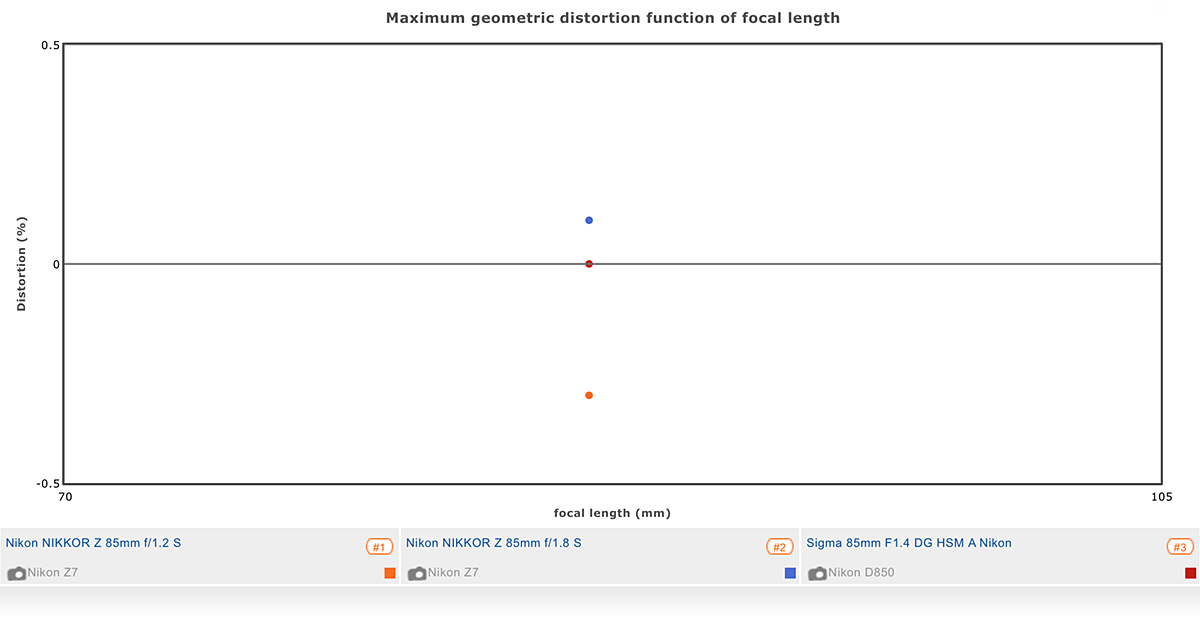
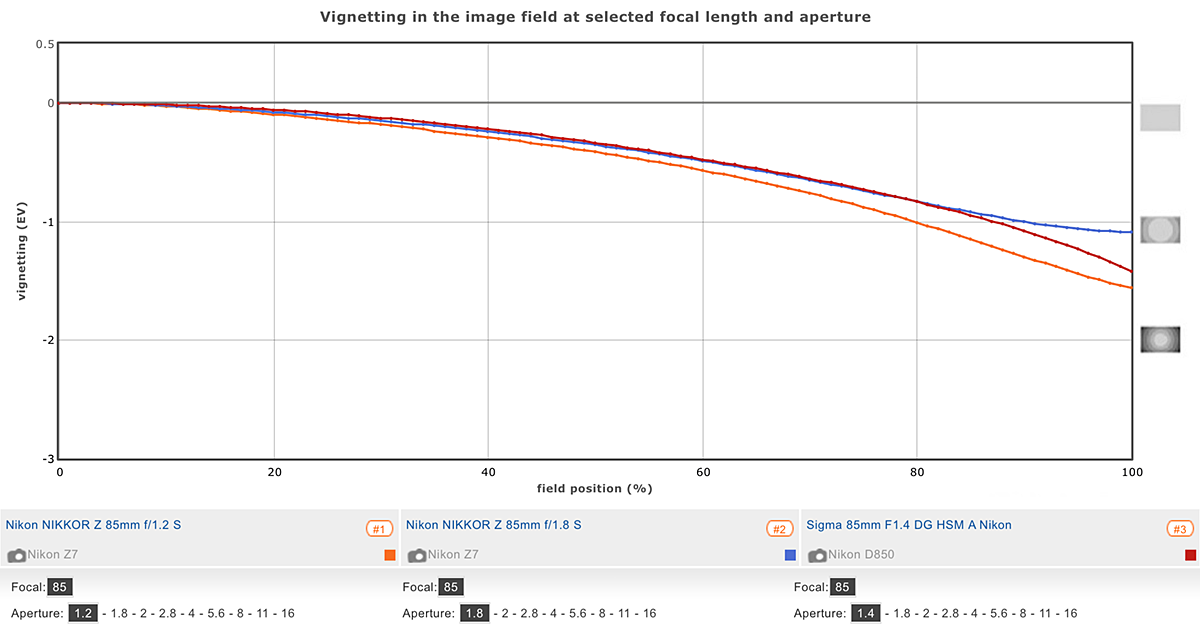
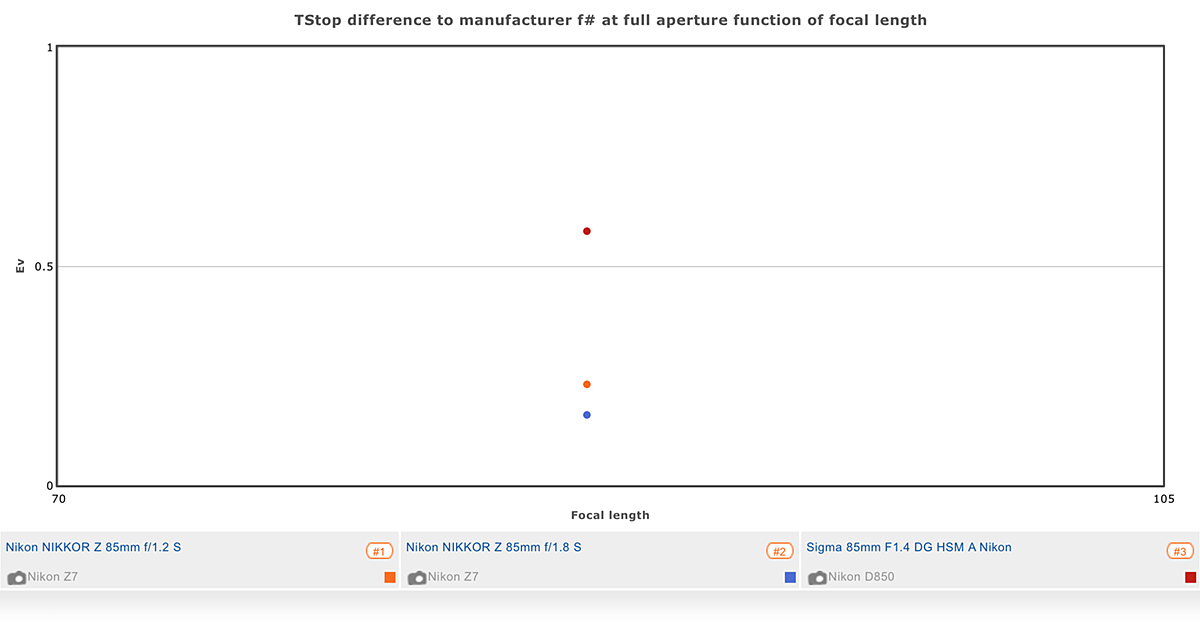
DXOMARK encourages its readers to share comments on the articles. To read or post comments, Disqus cookies are required. Change your Cookies Preferences and read more about our Comment Policy.